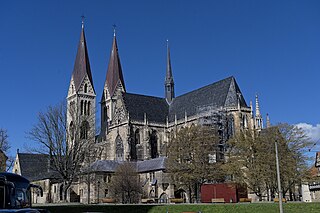
Halberstadt was a district (Kreis) in the middle of Saxony-Anhalt, Germany. Neighboring districts were Bördekreis, Quedlinburg, Wernigerode, Goslar, Wolfenbüttel, Helmstedt.

Hornburg is a town and a former municipality in the Wolfenbüttel district, in the German state of Lower Saxony. Since 1st November 2013, it is a part of the municipality Schladen-Werla. It is situated on the Ilse river, a tributary of the Oker. Hornburg is part of the Samtgemeinde Schladen and home to numerous historically valuable half-timber buildings (Fachwerkhäuser). It is located on the German Timber-Frame Road.

Halberstadt is a town in the German state of Saxony-Anhalt, the capital of Harz district. Located north of the Harz mountain range, it is known for its old town center, which was largely destroyed by Allied bombings in the late stages of World War II after local Nazi leaders refused to surrender. The town was rebuilt in the following decades.

Oschersleben is a town in the Börde district, in Saxony-Anhalt, Germany. The population in 1905 was 13,271, in 2020 about 19,000.

The Diocese of Halberstadt was a Roman Catholic diocese from 804 until 1648. From 1180, the bishops or administrators of Halberstadt ruled a state within the Holy Roman Empire, the prince-bishopric of Halberstadt. The diocesan seat and secular capital was Halberstadt in present-day Saxony-Anhalt.

Blankenburg (Harz) is a town and health resort in the district of Harz in Saxony-Anhalt, Germany, at the north foot of the Harz Mountains, 12 miles (19 km) southwest of Halberstadt.

Falkenstein/Harz is a town in the Harz district, in Saxony-Anhalt, Germany. It was created in 2002 by merging the town of Ermsleben with the former municipalities of Endorf, Meisdorf, Neuplatendorf, Pansfelde, Reinstedt und Wieserode. The new community was named after Falkenstein Castle.

Schwanebeck is a small town in the district of Harz, in Saxony-Anhalt, Germany. It is part of the Verbandsgemeinde Vorharz.

Wegeleben is a town in the Harz district, in Saxony-Anhalt, Germany. It is the administrative seat of the Verbandsgemeinde Vorharz.

Osterwieck is a historic town in the Harz district, in the German state of Saxony-Anhalt.

Jerichow is a town on the east side of the river Elbe, in the District of Jerichower Land, of the state of Saxony-Anhalt in Germany. With about 270 square kilometres (100 sq mi), the municipality of Jerichow is one of the largest municipalities in area size in Germany.

Rödern is an Ortsgemeinde – a municipality belonging to a Verbandsgemeinde, a kind of collective municipality – in the Rhein-Hunsrück-Kreis (district) in Rhineland-Palatinate, Germany. It belongs to the Verbandsgemeinde of Kirchberg, whose seat is in the town of Kirchberg.

Am Großen Bruch is a municipality in the Börde district in Saxony-Anhalt, Germany. It is part of the Verbandsgemeinde Westliche Börde. The municipality was created on 1 July 2004 by the merger of the former municipalities Gunsleben, Hamersleben and Neuwegersleben. On 1 January 2010 it absorbed the former municipality Wulferstedt.

The County of Wernigerode was a state of the Holy Roman Empire which arose in the Harzgau region of the former Duchy of Saxony, at the northern foot of the Harz mountain range. The comital residence was at Wernigerode, now part of Saxony-Anhalt, Germany. The county was ruled by a branch of the House of Stolberg from 1429 until its mediatization to the Kingdom of Prussia in 1806. Nevertheless, the county remained in existence - with one short interruption - until the dissolution of the Kingdom of Prussia in 1918.

Oberharz am Brocken is a town in the Harz District, in Saxony-Anhalt, Germany. It was formed on 1 January 2010 by the merger of the town of Elbingerode with the municipalities of the former Verwaltungsgemeinschaft Brocken-Hochharz.

The Grillenburg is a ruined medieval castle in Grillenberg in the district of Mansfeld-Südharz in the German state of Saxony-Anhalt. It was a small knight's castle built for a ministerialis.

Saaleck is a village in the former municipality of Bad Kösen, since 2010 part of the town of Naumburg in the district of Burgenlandkreis in the German state of Saxony-Anhalt.

Halberstadt station is a station on the Magdeburg–Thale railway in Halberstadt in the German state of Saxony-Anhalt. A terminal station was opened in the town in 1843. A new through station was opened in another part of the town in 1868. The first service from Halberstadt ran to Magdeburg. Two more lines were added during the next few decades. In the Second World War, the station suffered heavy damage. Extensive modernisation work took place between 2008 and 2010. The entrance building and the locomotive depot are listed buildings.

The Flechtingen water castle or Flechtingen moated castle is a largely well-preserved castle complex in the centre of the municipality of Flechtingen in the district of Börde in Saxony-Anhalt, Germany.





















